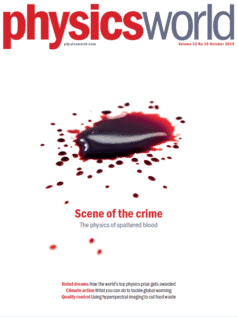What does it take to win a Nobel Prize for Physics? With this year’s prize due to be announced on 8 October, that’s the question Physics World asked Lars Brink, a Swedish particle theorist who has served on the Nobel Committee for Physics on eight occasions, including once as chairman.
You can read his insights in “Inside the Nobels” in the October 2019 issue of Physics World magazine, which is out now in print and digital formats. (You can also read the article online for free here.) The new issue has as well a special interview with Donna Strickland, who shared last year’s Nobel prize on what life’s been like for her over the past 12 months.

Elsewhere in the new issue, Sidney Perkowitz looks at how physics is helping to beef up the occasionally unreliable forensic technique of “blood-spatter analysis”, while James McKenzie examines the commercial prospects for LiFi – and explains why using light to transmit data might have some surprising applications.
Plus there’s our usual mix of news, opinion, reviews, careers and Lateral Thoughts.
You can enjoy the entire October 2019 issue of Physics World magazine via our digital apps for iOS, Android and Web browsers (membership of the Institute of Physics required).
Let us know what you think about the issue on Twitter, Facebook or by e-mailing us at pwld@ioppublishing.org.
For the record, here’s a full run-down of what’s in the issue.
• Life as a new Nobel laureate – What’s it like to win a Nobel Prize for Physics? Donna Strickland, the Canadian laser physicist who shared the 2018 prize, talks to Matin Durrani about her experiences over the last year
• Dealing with a climate emergency – Matthew Jones and Charles Adams say physicists need to change the way they work to make physics more sustainable
• On the retreat – If your life and livelihood were threatened by rising sea levels, where would you go and who would help? Robert P Crease reports from a conference on the difficulties of “managed retreat”
• Inside the Nobels – All of us dream of receiving a Nobel Prize for Physics, but how exactly do the winners get picked? Hamish Johnston gets the inside story from Lars Brink, a Swedish particle theorist who served on the Nobel Committee for Physics on eight separate occasions
• The physics of blood spatter – Analysing the blood stains following a shooting can be key to finding the perpetrator, but it’s a field of forensics that is being called into question. Sidney Perkowitz explains how understanding the physics behind the blood distribution could help uncover the truth
• Taking a bite out of food waste – Abi Ramanan describes how hyperspectral imaging and machine learning could change the future of food production, drastically reducing waste and increasing consumer satisfaction
• To boldly go – Ian Randall reviews The Consequential Frontier: Challenging the Privatization of Space by Peter Ward
• Meet the pup stars – Kate Gardner reviews Space Dogs: the Story of the Celebrated Canine Cosmonauts by Martin Parr and Richard Hollingham
• Heavenly vistas – Tushna Commissariat reviews Cosmos: the Art and Science of the Universe Roberta by J M Olson and Jay M Pasachoff
• Going the extracurricular mile – Getting experience beyond your core academic activities is crucial if you want to bag that dream job after graduating, as Institute of Physics careers manager Vishanti Fox explains
• There’s no place like home – Many physics graduates look for jobs in the towns or cities they already live in, rather than moving elsewhere. Andrew Hirst and Veronica Benson explore the implications of this “emotional geography” and discuss how universities can give physicists the skills local employers need
• Anything to declare? – Nicol Caplin on the news that the Israeli SpaceIL Beresheet lander – which crashed onto the lunar surface in April this year – was unknowingly carrying a payload full of reportedly indestructible biological samples.



